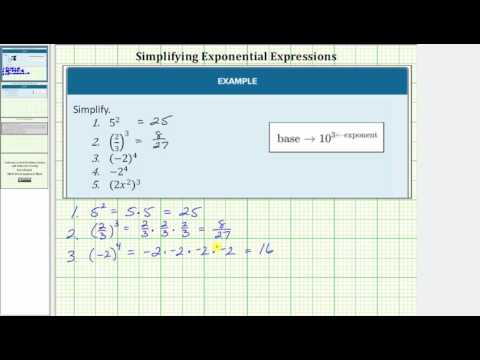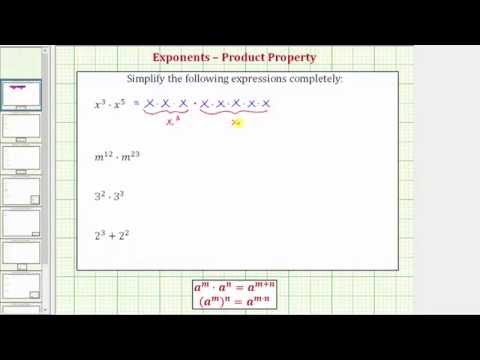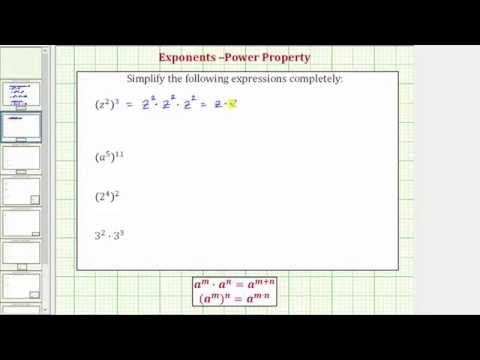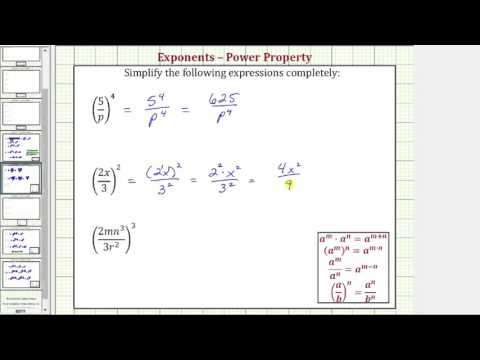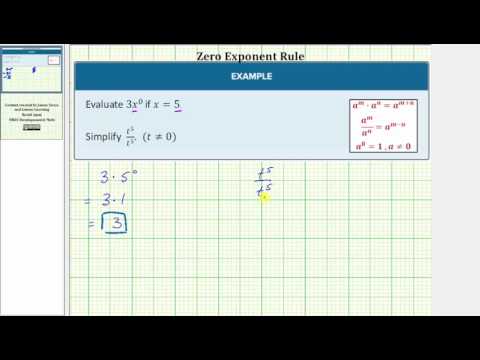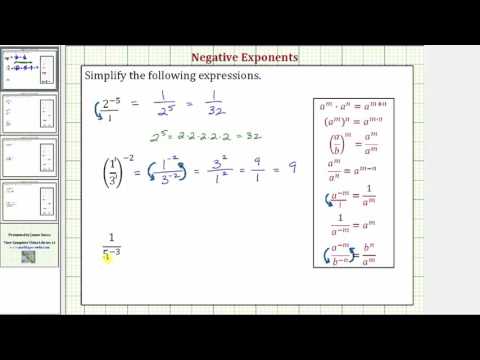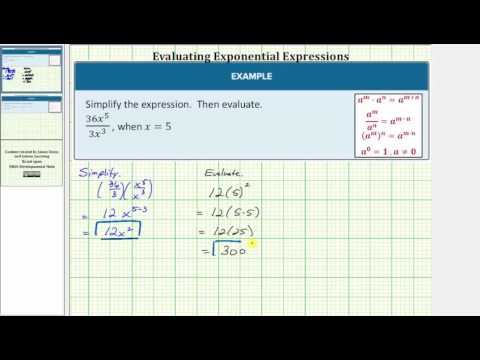4.3: Rules for Exponents
- Page ID
- 51460
\( \newcommand{\vecs}[1]{\overset { \scriptstyle \rightharpoonup} {\mathbf{#1}} } \)
\( \newcommand{\vecd}[1]{\overset{-\!-\!\rightharpoonup}{\vphantom{a}\smash {#1}}} \)
\( \newcommand{\dsum}{\displaystyle\sum\limits} \)
\( \newcommand{\dint}{\displaystyle\int\limits} \)
\( \newcommand{\dlim}{\displaystyle\lim\limits} \)
\( \newcommand{\id}{\mathrm{id}}\) \( \newcommand{\Span}{\mathrm{span}}\)
( \newcommand{\kernel}{\mathrm{null}\,}\) \( \newcommand{\range}{\mathrm{range}\,}\)
\( \newcommand{\RealPart}{\mathrm{Re}}\) \( \newcommand{\ImaginaryPart}{\mathrm{Im}}\)
\( \newcommand{\Argument}{\mathrm{Arg}}\) \( \newcommand{\norm}[1]{\| #1 \|}\)
\( \newcommand{\inner}[2]{\langle #1, #2 \rangle}\)
\( \newcommand{\Span}{\mathrm{span}}\)
\( \newcommand{\id}{\mathrm{id}}\)
\( \newcommand{\Span}{\mathrm{span}}\)
\( \newcommand{\kernel}{\mathrm{null}\,}\)
\( \newcommand{\range}{\mathrm{range}\,}\)
\( \newcommand{\RealPart}{\mathrm{Re}}\)
\( \newcommand{\ImaginaryPart}{\mathrm{Im}}\)
\( \newcommand{\Argument}{\mathrm{Arg}}\)
\( \newcommand{\norm}[1]{\| #1 \|}\)
\( \newcommand{\inner}[2]{\langle #1, #2 \rangle}\)
\( \newcommand{\Span}{\mathrm{span}}\) \( \newcommand{\AA}{\unicode[.8,0]{x212B}}\)
\( \newcommand{\vectorA}[1]{\vec{#1}} % arrow\)
\( \newcommand{\vectorAt}[1]{\vec{\text{#1}}} % arrow\)
\( \newcommand{\vectorB}[1]{\overset { \scriptstyle \rightharpoonup} {\mathbf{#1}} } \)
\( \newcommand{\vectorC}[1]{\textbf{#1}} \)
\( \newcommand{\vectorD}[1]{\overrightarrow{#1}} \)
\( \newcommand{\vectorDt}[1]{\overrightarrow{\text{#1}}} \)
\( \newcommand{\vectE}[1]{\overset{-\!-\!\rightharpoonup}{\vphantom{a}\smash{\mathbf {#1}}}} \)
\( \newcommand{\vecs}[1]{\overset { \scriptstyle \rightharpoonup} {\mathbf{#1}} } \)
\( \newcommand{\vecd}[1]{\overset{-\!-\!\rightharpoonup}{\vphantom{a}\smash {#1}}} \)
\(\newcommand{\avec}{\mathbf a}\) \(\newcommand{\bvec}{\mathbf b}\) \(\newcommand{\cvec}{\mathbf c}\) \(\newcommand{\dvec}{\mathbf d}\) \(\newcommand{\dtil}{\widetilde{\mathbf d}}\) \(\newcommand{\evec}{\mathbf e}\) \(\newcommand{\fvec}{\mathbf f}\) \(\newcommand{\nvec}{\mathbf n}\) \(\newcommand{\pvec}{\mathbf p}\) \(\newcommand{\qvec}{\mathbf q}\) \(\newcommand{\svec}{\mathbf s}\) \(\newcommand{\tvec}{\mathbf t}\) \(\newcommand{\uvec}{\mathbf u}\) \(\newcommand{\vvec}{\mathbf v}\) \(\newcommand{\wvec}{\mathbf w}\) \(\newcommand{\xvec}{\mathbf x}\) \(\newcommand{\yvec}{\mathbf y}\) \(\newcommand{\zvec}{\mathbf z}\) \(\newcommand{\rvec}{\mathbf r}\) \(\newcommand{\mvec}{\mathbf m}\) \(\newcommand{\zerovec}{\mathbf 0}\) \(\newcommand{\onevec}{\mathbf 1}\) \(\newcommand{\real}{\mathbb R}\) \(\newcommand{\twovec}[2]{\left[\begin{array}{r}#1 \\ #2 \end{array}\right]}\) \(\newcommand{\ctwovec}[2]{\left[\begin{array}{c}#1 \\ #2 \end{array}\right]}\) \(\newcommand{\threevec}[3]{\left[\begin{array}{r}#1 \\ #2 \\ #3 \end{array}\right]}\) \(\newcommand{\cthreevec}[3]{\left[\begin{array}{c}#1 \\ #2 \\ #3 \end{array}\right]}\) \(\newcommand{\fourvec}[4]{\left[\begin{array}{r}#1 \\ #2 \\ #3 \\ #4 \end{array}\right]}\) \(\newcommand{\cfourvec}[4]{\left[\begin{array}{c}#1 \\ #2 \\ #3 \\ #4 \end{array}\right]}\) \(\newcommand{\fivevec}[5]{\left[\begin{array}{r}#1 \\ #2 \\ #3 \\ #4 \\ #5 \\ \end{array}\right]}\) \(\newcommand{\cfivevec}[5]{\left[\begin{array}{c}#1 \\ #2 \\ #3 \\ #4 \\ #5 \\ \end{array}\right]}\) \(\newcommand{\mattwo}[4]{\left[\begin{array}{rr}#1 \amp #2 \\ #3 \amp #4 \\ \end{array}\right]}\) \(\newcommand{\laspan}[1]{\text{Span}\{#1\}}\) \(\newcommand{\bcal}{\cal B}\) \(\newcommand{\ccal}{\cal C}\) \(\newcommand{\scal}{\cal S}\) \(\newcommand{\wcal}{\cal W}\) \(\newcommand{\ecal}{\cal E}\) \(\newcommand{\coords}[2]{\left\{#1\right\}_{#2}}\) \(\newcommand{\gray}[1]{\color{gray}{#1}}\) \(\newcommand{\lgray}[1]{\color{lightgray}{#1}}\) \(\newcommand{\rank}{\operatorname{rank}}\) \(\newcommand{\row}{\text{Row}}\) \(\newcommand{\col}{\text{Col}}\) \(\renewcommand{\row}{\text{Row}}\) \(\newcommand{\nul}{\text{Nul}}\) \(\newcommand{\var}{\text{Var}}\) \(\newcommand{\corr}{\text{corr}}\) \(\newcommand{\len}[1]{\left|#1\right|}\) \(\newcommand{\bbar}{\overline{\bvec}}\) \(\newcommand{\bhat}{\widehat{\bvec}}\) \(\newcommand{\bperp}{\bvec^\perp}\) \(\newcommand{\xhat}{\widehat{\xvec}}\) \(\newcommand{\vhat}{\widehat{\vvec}}\) \(\newcommand{\uhat}{\widehat{\uvec}}\) \(\newcommand{\what}{\widehat{\wvec}}\) \(\newcommand{\Sighat}{\widehat{\Sigma}}\) \(\newcommand{\lt}{<}\) \(\newcommand{\gt}{>}\) \(\newcommand{\amp}{&}\) \(\definecolor{fillinmathshade}{gray}{0.9}\)Learning Objectives
- Product and Quotient Rules
- Use the product rule to multiply exponential expressions
- Use the quotient rule to divide exponential expressions
- The Power Rule for Exponents
- Use the power rule to simplify expressions involving products, quotients, and exponents
- Negative and Zero Exponents
- Define and use the zero exponent rule
- Define and use the negative exponent rule
- Simplify Expressions Using the Exponent Rules
- Simplify expressions using a combination of the exponent rules
- Simplify compound exponential expressions with negative exponents

Anatomy of exponential terms
We use exponential notation to write repeated multiplication. For example \(10^{3}\). The 10 in \(10^{3}\) is called the exponent. The expression \(10^{3}\) is called the exponential expression. Knowing the names for the parts of an exponential expression or term will help you learn how to perform mathematical operations on them.
\(\text{base}\rightarrow10^{3\leftarrow\text{exponent}}\)
\(10\cdot10\cdot10\), or 1,000.
\(8\cdot8\), or 64.
\(5\cdot5\cdot5\cdot5\), or 625.
\({b}\cdot{b}\cdot{b}\cdot{b}\cdot{b}\). Its value will depend on the value of b.
The exponent applies only to the number that it is next to. Therefore, in the expression \(xy^{4}\) means \({x}\cdot{y}\cdot{y}\cdot{y}\cdot{y}\). The x in this term is a coefficient of y.
If the exponential expression is negative, such as \(–\left(3\cdot3\cdot3\cdot3\right)\) or \(−81\).
If \(\left(−3\right)^{4}\), which means \(−3\cdot−3\cdot−3\cdot−3\), or 81.
Likewise, \(−x^{4}=–\left(x\cdot x\cdot x\cdot x\right)\).
You can see that there is quite a difference, so you have to be very careful! The following examples show how to identify the base and the exponent, as well as how to identify the expanded and exponential format of writing repeated multiplication.
Example
Identify the exponent and the base in the following terms, then simplify:
- \(7^{2}\)
- \({\left(\frac{1}{2}\right)}^{3}\)
- \(2x^{3}\)
- \(\left(-5\right)^{2}\)
[reveal-answer q=”211363″]Show Solution[/reveal-answer]
[hidden-answer a=”211363″]
1) \(7^{2}\)
The exponent in this term is 2 and the base is 7. To simplify, expand the term: \(7^{2}=7\cdot{7}=49\)
2) \({\left(\frac{1}{2}\right)}^{3}\)
The exponent on this term is 3, and the base is \({\left(\frac{1}{2}\right)}^{3}=\frac{1}{2}\cdot{\frac{1}{2}}\cdot{\frac{1}{2}}=\frac{1}{16}\)
3) \(2x^{3}\)
The exponent on this term is 3, and the base is x, the 2 is not getting the exponent because there are no parentheses that tell us it is. This term is in its most simplified form.
4) \(\left(-5\right)^{2}\)
The exponent on this terms is 2 and the base is \(\left(-5\right)^{2}=-5\cdot{-5}=25\)
[/hidden-answer]
In the following video you are provided more examples of applying exponents to various bases.
Evaluate expressions
Evaluating expressions containing exponents is the same as evaluating the linear expressions from earlier in the course. You substitute the value of the variable into the expression and simplify.
You can use the order of operations to evaluate the expressions containing exponents. First, evaluate anything in Parentheses or grouping symbols. Next, look for Exponents, followed by Multiplication and Division (reading from left to right), and lastly, Addition and Subtraction (again, reading from left to right).
So, when you evaluate the expression \(x=4\), first substitute the value 4 for the variable x. Then evaluate, using order of operations.
Example
Evaluate \(x=4\).
[reveal-answer q=”411363″]Show Solution[/reveal-answer]
[hidden-answer a=”411363″]
Substitute 4 for the variable x.
\(5\cdot4^{3}\)
Evaluate \(4^{3}\). Multiply.
\(5\left(4\cdot4\cdot4\right)=5\cdot64=320\)
Answer
\(x=4\)
[/hidden-answer]
In the example below, notice the how adding parentheses can change the outcome when you are simplifying terms with exponents.
Example
Evaluate \(x=4\).
[reveal-answer q=”362021″]Show Solution[/reveal-answer]
[hidden-answer a=”362021″]Substitute 4 for the variable x.
\(\left(5\cdot4\right)3\)
Multiply inside the parentheses, then apply the exponent—following the rules of PEMDAS.
\(20^{3}\)
Evaluate \(20^{3}\).
\(20\cdot20\cdot20=8,000\)
Answer
\(x=4\)
[/hidden-answer]
The addition of parentheses made quite a difference! Parentheses allow you to apply an exponent to variables or numbers that are multiplied, divided, added, or subtracted to each other.
Example
Evaluate \(x=−4\).
[reveal-answer q=”86290″]Show Solution[/reveal-answer]
[hidden-answer a=”86290″]Substitute \(−4\) for the variable x.
\(\left(−4\right)^{3}\)
Evaluate. Note how placing parentheses around the \(−4\) means the negative sign also gets multiplied.
\(−4\cdot−4\cdot−4\)
Multiply.
\(−4\cdot−4\cdot−4=−64\)
Answer
\(x=−4\)
[/hidden-answer]

Caution! Whether to include a negative sign as part of a base or not often leads to confusion. To clarify whether a negative sign is applied before or after the exponent, here is an example.
What is the difference in the way you would evaluate these two terms?
- \(-{3}^{2}\)
- \({\left(-3\right)}^{2}\)
To evaluate 1), you would apply the exponent to the three first, then apply the negative sign last, like this:
\(\begin{array}{c}-\left({3}^{2}\right)\\=-\left(9\right) = -9\end{array}\)
To evaluate 2), you would apply the exponent to the 3 and the negative sign:
\(\begin{array}{c}{\left(-3\right)}^{2}\\=\left(-3\right)\cdot\left(-3\right)\\={ 9}\end{array}\)
The key to remembering this is to follow the order of operations. The first expression does not include parentheses so you would apply the exponent to the integer 3 first, then apply the negative sign. The second expression includes parentheses, so hopefully you will remember that the negative sign also gets squared.
In the next sections, you will learn how to simplify expressions that contain exponents. Come back to this page if you forget how to apply the order of operations to a term with exponents, or forget which is the base and which is the exponent!
In the following video you are provided with examples of evaluating exponential expressions for a given number.
Use the product rule to multiply exponential expressions
Exponential notation was developed to write repeated multiplication more efficiently. There are times when it is easier or faster to leave the expressions in exponential notation when multiplying or dividing. Let’s look at rules that will allow you to do this.
For example, the notation \(5\cdot5\cdot5\cdot5\), or 625. And don’t forget, the exponent only applies to the number immediately to its left, unless there are parentheses.
What happens if you multiply two numbers in exponential form with the same base? Consider the expression \(\left(2\cdot2\cdot2\right)\left(2\cdot2\cdot2\cdot2\right)\) or \(2^{7}\). Notice that 7 is the sum of the original two exponents, 3 and 4.
What about \(\left(x\cdot{x}\right)\left(x\cdot{x}\cdot{x}\cdot{x}\cdot{x}\cdot{x}\right)=x\cdot{x}\cdot{x}\cdot{x}\cdot{x}\cdot{x}\cdot{x}\cdot{x}\) or \(x^{8}\). And, once again, 8 is the sum of the original two exponents. This concept can be generalized in the following way:
The Product Rule for Exponents
For any number x and any integers a and b, \(\left(x^{a}\right)\left(x^{b}\right) = x^{a+b}\).
To multiply exponential terms with the same base, add the exponents.
 Caution! When you are reading mathematical rules, it is important to pay attention to the conditions on the rule. For example, when using the product rule, you may only apply it when the terms being multiplied have the same base and the exponents are integers. Conditions on mathematical rules are often given before the rule is stated, as in this example it says “For any number x, and any integers a and b.”
Caution! When you are reading mathematical rules, it is important to pay attention to the conditions on the rule. For example, when using the product rule, you may only apply it when the terms being multiplied have the same base and the exponents are integers. Conditions on mathematical rules are often given before the rule is stated, as in this example it says “For any number x, and any integers a and b.”
Example
Simplify.
\((a^{3})(a^{7})\)
[reveal-answer q=”356596″]Show Solution[/reveal-answer]
[hidden-answer a=”356596″]The base of both exponents is a, so the product rule applies.
\(\left(a^{3}\right)\left(a^{7}\right)\)
Add the exponents with a common base.
\(a^{3+7}\)
Answer
\(\left(a^{3}\right)\left(a^{7}\right) = a^{10}\)
[/hidden-answer]
When multiplying more complicated terms, multiply the coefficients and then multiply the variables.
Example
Simplify.
\(5a^{4}\cdot7a^{6}\)
[reveal-answer q=”215459″]Show Solution[/reveal-answer]
[hidden-answer a=”215459″]Multiply the coefficients.
\(35\cdot{a}^{4}\cdot{a}^{6}\)
The base of both exponents is a, so the product rule applies. Add the exponents.
\(35\cdot{a}^{4+6}\)
Add the exponents with a common base.
\(35\cdot{a}^{10}\)
Answer
\(5a^{4}\cdot7a^{6}=35a^{10}\)
[/hidden-answer]
Caution! Do not try to apply this rule to sums.
Think about the expression \(\left(2+3\right)^{2}\)
Does \(2^{2}+3^{2}\)?
No, it does not because of the order of operations!
\(\left(2+3\right)^{2}=5^{2}=25\)
and
\(2^{2}+3^{2}=4+9=13\)
Therefore, you can only use this rule when the numbers inside the parentheses are being multiplied (or divided, as we will see next).
Use the quotient rule to divide exponential expressions
Let’s look at dividing terms containing exponential expressions. What happens if you divide two numbers in exponential form with the same base? Consider the following expression.
\(\displaystyle \frac
Callstack:
at (Courses/Lumen_Learning/Beginning_Algebra_(Lumen)/04:_Exponents/4.03:_Rules_for_Exponents), /content/body/div[5]/p[2]/span[1], line 1, column 3
Callstack:
at (Courses/Lumen_Learning/Beginning_Algebra_(Lumen)/04:_Exponents/4.03:_Rules_for_Exponents), /content/body/div[5]/p[2]/span[2], line 1, column 3
You can rewrite the expression as: \(\displaystyle\)
Finally, this expression can be rewritten as \(4^{3}\) using exponential notation. Notice that the exponent, 3, is the difference between the two exponents in the original expression, 5 and 2.
So, \(\displaystyle \frac
Callstack:
at (Courses/Lumen_Learning/Beginning_Algebra_(Lumen)/04:_Exponents/4.03:_Rules_for_Exponents), /content/body/div[5]/p[5]/span[1], line 1, column 3
Callstack:
at (Courses/Lumen_Learning/Beginning_Algebra_(Lumen)/04:_Exponents/4.03:_Rules_for_Exponents), /content/body/div[5]/p[5]/span[2], line 1, column 3
Be careful that you subtract the exponent in the denominator from the exponent in the numerator.
So, to divide two exponential terms with the same base, subtract the exponents.
The Quotient (Division) Rule for Exponents
For any non-zero number x and any integers a and b: \(\displaystyle \frac
Callstack:
at (Courses/Lumen_Learning/Beginning_Algebra_(Lumen)/04:_Exponents/4.03:_Rules_for_Exponents), /content/body/div[5]/div[1]/div/p/span[1], line 1, column 3
Callstack:
at (Courses/Lumen_Learning/Beginning_Algebra_(Lumen)/04:_Exponents/4.03:_Rules_for_Exponents), /content/body/div[5]/div[1]/div/p/span[2], line 1, column 3
Callstack:
at (Courses/Lumen_Learning/Beginning_Algebra_(Lumen)/04:_Exponents/4.03:_Rules_for_Exponents), /content/body/div[5]/div[1]/div/p/span[3], line 1, column 2
Example
Evaluate. \(\displaystyle \frac
Callstack:
at (Courses/Lumen_Learning/Beginning_Algebra_(Lumen)/04:_Exponents/4.03:_Rules_for_Exponents), /content/body/div[5]/div[2]/p[1]/span[1], line 1, column 3
Callstack:
at (Courses/Lumen_Learning/Beginning_Algebra_(Lumen)/04:_Exponents/4.03:_Rules_for_Exponents), /content/body/div[5]/div[2]/p[1]/span[2], line 1, column 3
[reveal-answer q=”96156″]Show Solution[/reveal-answer]
[hidden-answer a=”96156″]These two exponents have the same base, 4. According to the Quotient Rule, you can subtract the power in the denominator from the power in the numerator.
\(\displaystyle
Callstack:
at (Courses/Lumen_Learning/Beginning_Algebra_(Lumen)/04:_Exponents/4.03:_Rules_for_Exponents), /content/body/div[5]/div[2]/p[3]/span, line 1, column 2
Answer
\(\displaystyle \frac
Callstack:
at (Courses/Lumen_Learning/Beginning_Algebra_(Lumen)/04:_Exponents/4.03:_Rules_for_Exponents), /content/body/div[5]/div[2]/div/p[1]/span[1], line 1, column 3
Callstack:
at (Courses/Lumen_Learning/Beginning_Algebra_(Lumen)/04:_Exponents/4.03:_Rules_for_Exponents), /content/body/div[5]/div[2]/div/p[1]/span[2], line 1, column 3
[/hidden-answer]
When dividing terms that also contain coefficients, divide the coefficients and then divide variable powers with the same base by subtracting the exponents.
Example
Simplify. \(\displaystyle \frac{12
Callstack:
at (Courses/Lumen_Learning/Beginning_Algebra_(Lumen)/04:_Exponents/4.03:_Rules_for_Exponents), /content/body/div[5]/div[3]/p[1]/span, line 1, column 2
[reveal-answer q=”23604″]Show Solution[/reveal-answer]
[hidden-answer a=”23604″]Separate into numerical and variable factors.
\(\displaystyle \left( \frac{12}{2} \right)\left( \frac
Callstack:
at (Courses/Lumen_Learning/Beginning_Algebra_(Lumen)/04:_Exponents/4.03:_Rules_for_Exponents), /content/body/div[5]/div[3]/p[3]/span, line 1, column 3
Since the bases of the exponents are the same, you can apply the Quotient Rule. Divide the coefficients and subtract the exponents of matching variables.
\(\displaystyle 6\left(
Callstack:
at (Courses/Lumen_Learning/Beginning_Algebra_(Lumen)/04:_Exponents/4.03:_Rules_for_Exponents), /content/body/div[5]/div[3]/p[5]/span, line 1, column 2
Answer
\(\displaystyle 6
Callstack:
at (Courses/Lumen_Learning/Beginning_Algebra_(Lumen)/04:_Exponents/4.03:_Rules_for_Exponents), /content/body/div[5]/div[3]/div/p[1]/span, line 1, column 2
[/hidden-answer]
In the following video we show another example of how to use the quotient rule to divide exponential expressions
Raise powers to powers
Another word for exponent is power. You have likely seen or heard an example such as \(3^5\) can be described as 3 raised to the 5th power. In this section we will further expand our capabilities with exponents. We will learn what to do when a term with a power is raised to another power, and what to do when two numbers or variables are multiplied and both are raised to an exponent. We will also learn what to do when numbers or variables that are divided are raised to a power. We will begin by raising powers to powers.
Let’s simplify \(5^2\) and the exponent is 4, so you multiply \(\left(5^{2}\right)^{4}=5^{2}\cdot5^{2}\cdot5^{2}\cdot5^{2}=5^{8}\) (using the Product Rule—add the exponents).
\(5^{8}\). Notice that the new exponent is the same as the product of the original exponents: \(2\cdot4=8\).
So, \(\left(5^{2}\right)^{4}=5^{2\cdot4}=5^{8}\) (which equals 390,625, if you do the multiplication).
Likewise, \(\left(x^{4}\right)^{3}=x^{4\cdot3}=x^{12}\)
This leads to another rule for exponents—the Power Rule for Exponents. To simplify a power of a power, you multiply the exponents, keeping the base the same. For example, \(\left(2^{3}\right)^{5}=2^{15}\).
The Power Rule for Exponents
For any positive number x and integers a and b: \(\left(x^{a}\right)^{b}=x^{a\cdot{b}}\).
Take a moment to contrast how this is different from the product rule for exponents found on the previous page.
Example
Simplify \(6\left(c^{4}\right)^{2}\).
[reveal-answer q=”841688″]Show Solution[/reveal-answer]
[hidden-answer a=”841688″]Since you are raising a power to a power, apply the Power Rule and multiply exponents to simplify. The coefficient remains unchanged because it is outside of the parentheses.
\(6\left(c^{4}\right)^{2}\)
Answer
\(6\left(c^{4}\right)^{2}=6c^{8}\)
[/hidden-answer]
Raise a product to a power
Simplify this expression.
\(\left(2a\right)^{4}=\left(2a\right)\left(2a\right)\left(2a\right)\left(2a\right)=\left(2\cdot2\cdot2\cdot2\right)\left(a\cdot{a}\cdot{a}\cdot{a}\cdot{a}\right)=\left(2^{4}\right)\left(a^{4}\right)=16a^{4}\)
Notice that the exponent is applied to each factor of 2a. So, we can eliminate the middle steps.
\(\begin{array}{l}\left(2a\right)^{4} = \left(2^{4}\right)\left(a^{4}\right)\text{, applying the }4\text{ to each factor, }2\text{ and }a\\\\\,\,\,\,\,\,\,\,\,\,\,\,\,=16a^{4}\end{array}\)
The product of two or more numbers raised to a power is equal to the product of each number raised to the same power.
A Product Raised to a Power
For any nonzero numbers a and b and any integer x, \(\left(ab\right)^{x}=a^{x}\cdot{b^{x}}\).
How is this rule different from the power raised to a power rule? How is it different from the product rule for exponents on the previous page?
Example
Simplify. \(\left(2yz\right)^{6}\)
[reveal-answer q=”368657″]Show Solution[/reveal-answer]
[hidden-answer a=”368657″]
Apply the exponent to each number in the product.
\(2^{6}y^{6}z^{6}\)
Answer
\(\left(2yz\right)^{6}=64y^{6}z^{6}\)
[/hidden-answer]
If the variable has an exponent with it, use the Power Rule: multiply the exponents.
Example
Simplify. \(\left(−7a^{4}b\right)^{2}\)
[reveal-answer q=”136794″]Show Solution[/reveal-answer]
[hidden-answer a=”136794″]Apply the exponent 2 to each factor within the parentheses.
\(\left(−7\right)^{2}\left(a^{4}\right)^{2}\left(b\right)^{2}\)
Square the coefficient and use the Power Rule to square \(\left(a^{4}\right)^{2}\).
\(49a^{4\cdot2}b^{2}\)
Simplify.
\(49a^{8}b^{2}\)
Answer
\(\left(-7a^{4}b\right)^{2}=49a^{8}b^{2}\)
[/hidden-answer]
Raise a quotient to a power
Now let’s look at what happens if you raise a quotient to a power. Remember that quotient means divide. Suppose you have \(\displaystyle \frac{3}{4}\) and raise it to the 3rd power.
\(\displaystyle
Callstack:
at (Courses/Lumen_Learning/Beginning_Algebra_(Lumen)/04:_Exponents/4.03:_Rules_for_Exponents), /content/body/div[6]/div[3]/div[4]/p[2]/span[1], line 1, column 1
Callstack:
at (Courses/Lumen_Learning/Beginning_Algebra_(Lumen)/04:_Exponents/4.03:_Rules_for_Exponents), /content/body/div[6]/div[3]/div[4]/p[2]/span[2], line 1, column 3
Callstack:
at (Courses/Lumen_Learning/Beginning_Algebra_(Lumen)/04:_Exponents/4.03:_Rules_for_Exponents), /content/body/div[6]/div[3]/div[4]/p[2]/span[3], line 1, column 3
You can see that raising the quotient to the power of 3 can also be written as the numerator (3) to the power of 3, and the denominator (4) to the power of 3.
Similarly, if you are using variables, the quotient raised to a power is equal to the numerator raised to the power over the denominator raised to power.
\(\displaystyle
Callstack:
at (Courses/Lumen_Learning/Beginning_Algebra_(Lumen)/04:_Exponents/4.03:_Rules_for_Exponents), /content/body/div[6]/div[3]/div[4]/p[5]/span[1], line 1, column 1
Callstack:
at (Courses/Lumen_Learning/Beginning_Algebra_(Lumen)/04:_Exponents/4.03:_Rules_for_Exponents), /content/body/div[6]/div[3]/div[4]/p[5]/span[2], line 1, column 3
Callstack:
at (Courses/Lumen_Learning/Beginning_Algebra_(Lumen)/04:_Exponents/4.03:_Rules_for_Exponents), /content/body/div[6]/div[3]/div[4]/p[5]/span[3], line 1, column 3
When a quotient is raised to a power, you can apply the power to the numerator and denominator individually, as shown below.
\(\displaystyle
Callstack:
at (Courses/Lumen_Learning/Beginning_Algebra_(Lumen)/04:_Exponents/4.03:_Rules_for_Exponents), /content/body/div[6]/div[3]/div[4]/p[7]/span[1], line 1, column 1
Callstack:
at (Courses/Lumen_Learning/Beginning_Algebra_(Lumen)/04:_Exponents/4.03:_Rules_for_Exponents), /content/body/div[6]/div[3]/div[4]/p[7]/span[2], line 1, column 3
Callstack:
at (Courses/Lumen_Learning/Beginning_Algebra_(Lumen)/04:_Exponents/4.03:_Rules_for_Exponents), /content/body/div[6]/div[3]/div[4]/p[7]/span[3], line 1, column 3
A Quotient Raised to a Power
For any number a, any non-zero number b, and any integer x, \(\displaystyle {\left(\frac{a}{b}\right)}^{x}=\frac{a^{x}}{b^{x}}\).
Example
Simplify. \(\displaystyle
Callstack:
at (Courses/Lumen_Learning/Beginning_Algebra_(Lumen)/04:_Exponents/4.03:_Rules_for_Exponents), /content/body/div[6]/div[3]/div[4]/div[2]/p[1]/span, line 1, column 1
[reveal-answer q=”875425″]Show Solution[/reveal-answer]
[hidden-answer a=”875425″]Apply the power to each factor individually.
\(\displaystyle \frac
Callstack:
at (Courses/Lumen_Learning/Beginning_Algebra_(Lumen)/04:_Exponents/4.03:_Rules_for_Exponents), /content/body/div[6]/div[3]/div[4]/div[2]/p[3]/span[1], line 1, column 3
Callstack:
at (Courses/Lumen_Learning/Beginning_Algebra_(Lumen)/04:_Exponents/4.03:_Rules_for_Exponents), /content/body/div[6]/div[3]/div[4]/div[2]/p[3]/span[2], line 1, column 3
Separate into numerical and variable factors.
\(\displaystyle
Callstack:
at (Courses/Lumen_Learning/Beginning_Algebra_(Lumen)/04:_Exponents/4.03:_Rules_for_Exponents), /content/body/div[6]/div[3]/div[4]/div[2]/p[5]/span[1], line 1, column 2
Callstack:
at (Courses/Lumen_Learning/Beginning_Algebra_(Lumen)/04:_Exponents/4.03:_Rules_for_Exponents), /content/body/div[6]/div[3]/div[4]/div[2]/p[5]/span[2], line 1, column 3
Callstack:
at (Courses/Lumen_Learning/Beginning_Algebra_(Lumen)/04:_Exponents/4.03:_Rules_for_Exponents), /content/body/div[6]/div[3]/div[4]/div[2]/p[5]/span[3], line 1, column 3
Callstack:
at (Courses/Lumen_Learning/Beginning_Algebra_(Lumen)/04:_Exponents/4.03:_Rules_for_Exponents), /content/body/div[6]/div[3]/div[4]/div[2]/p[5]/span[4], line 1, column 3
Simplify by taking 2 to the third power and applying the Power and Quotient Rules for exponents—multiply and subtract the exponents of matching variables.
\(\displaystyle 8\cdot
Callstack:
at (Courses/Lumen_Learning/Beginning_Algebra_(Lumen)/04:_Exponents/4.03:_Rules_for_Exponents), /content/body/div[6]/div[3]/div[4]/div[2]/p[7]/span[1], line 1, column 2
Callstack:
at (Courses/Lumen_Learning/Beginning_Algebra_(Lumen)/04:_Exponents/4.03:_Rules_for_Exponents), /content/body/div[6]/div[3]/div[4]/div[2]/p[7]/span[2], line 1, column 2
Simplify.
\(\displaystyle 8
Callstack:
at (Courses/Lumen_Learning/Beginning_Algebra_(Lumen)/04:_Exponents/4.03:_Rules_for_Exponents), /content/body/div[6]/div[3]/div[4]/div[2]/p[9]/span[1], line 1, column 2
Callstack:
at (Courses/Lumen_Learning/Beginning_Algebra_(Lumen)/04:_Exponents/4.03:_Rules_for_Exponents), /content/body/div[6]/div[3]/div[4]/div[2]/p[9]/span[2], line 1, column 2
Answer
\(\displaystyle
Callstack:
at (Courses/Lumen_Learning/Beginning_Algebra_(Lumen)/04:_Exponents/4.03:_Rules_for_Exponents), /content/body/div[6]/div[3]/div[4]/div[2]/div/p[1]/span[1], line 1, column 1
Callstack:
at (Courses/Lumen_Learning/Beginning_Algebra_(Lumen)/04:_Exponents/4.03:_Rules_for_Exponents), /content/body/div[6]/div[3]/div[4]/div[2]/div/p[1]/span[2], line 1, column 2
Callstack:
at (Courses/Lumen_Learning/Beginning_Algebra_(Lumen)/04:_Exponents/4.03:_Rules_for_Exponents), /content/body/div[6]/div[3]/div[4]/div[2]/div/p[1]/span[3], line 1, column 2
[/hidden-answer]
In the following video you will be shown examples of simplifying quotients that are raised to a power.
Define and use the zero exponent rule
When we defined the quotient rule, we only worked with expressions like the following: \(\frac
Callstack:
at (Courses/Lumen_Learning/Beginning_Algebra_(Lumen)/04:_Exponents/4.03:_Rules_for_Exponents), /content/body/div[7]/p/span[1], line 1, column 3
Callstack:
at (Courses/Lumen_Learning/Beginning_Algebra_(Lumen)/04:_Exponents/4.03:_Rules_for_Exponents), /content/body/div[7]/p/span[2], line 1, column 3
What if the exponent is zero?
To see how this is defined, let us begin with an example. We will use the idea that dividing any number by itself gives a result of 1.
\(\frac{t^{8}}{t^{8}}=\frac{\cancel{t^{8}}}{\cancel{t^{8}}}=1\)
If we were to simplify the original expression using the quotient rule, we would have
\(\frac
Callstack:
at (Courses/Lumen_Learning/Beginning_Algebra_(Lumen)/04:_Exponents/4.03:_Rules_for_Exponents), /content/body/div[7]/div/p[4]/span[1], line 1, column 2
Callstack:
at (Courses/Lumen_Learning/Beginning_Algebra_(Lumen)/04:_Exponents/4.03:_Rules_for_Exponents), /content/body/div[7]/div/p[4]/span[2], line 1, column 2
If we equate the two answers, the result is \({t}^{0}=1\). This is true for any nonzero real number, or any variable representing a real number.
The sole exception is the expression \({0}^{0}\). This appears later in more advanced courses, but for now, we will consider the value to be undefined, or DNE (Does Not Exist).
Exponents of 0 or 1
Any number or variable raised to a power of 1 is the number itself.
\(n^{1}=n\)
Any non-zero number or variable raised to a power of 0 is equal to 1
\(n^{0}=1\)
The quantity \(0^{0}\) is undefined.
As done previously, to evaluate expressions containing exponents of 0 or 1, substitute the value of the variable into the expression and simplify.
Example
Evaluate \(x=9\)
[reveal-answer q=”324798″]Show Solution[/reveal-answer]
[hidden-answer a=”324798″]Substitute 9 for the variable x.
\(2\cdot9^{0}\)
Evaluate \(9^{0}\). Multiply.
\(2\cdot1=2\)
Answer
\(x=9\)
[/hidden-answer]
Example
Simplify \(\frac
Callstack:
at (Courses/Lumen_Learning/Beginning_Algebra_(Lumen)/04:_Exponents/4.03:_Rules_for_Exponents), /content/body/div[7]/div/div[4]/p[1]/span[1], line 1, column 2
Callstack:
at (Courses/Lumen_Learning/Beginning_Algebra_(Lumen)/04:_Exponents/4.03:_Rules_for_Exponents), /content/body/div[7]/div/div[4]/p[1]/span[2], line 1, column 2
[reveal-answer q=”769979″]Show Solution[/reveal-answer]
[hidden-answer a=”769979″]Use the quotient and zero exponent rules to simplify the expression.
\(\begin{array}\text{ }\frac{c^{3}}{c^{3}} \,\,\,= \,\,\,c^{3-3} \\ \,\,\,\,\,\,\,\,\,\,\,=\,\,\,c^{0} \\\,\,\,\,\,\,\,\,\,\,\,=\,\,\,1\end{array}\)
Answer
1
[/hidden-answer]
In the following video there is an example of evaluating an expression with an exponent of zero, as well as simplifying when you get a result of a zero exponent.
Define and use the negative exponent rule
We proposed another question at the beginning of this section. Given a quotient like \(\displaystyle \frac
Callstack:
at (Courses/Lumen_Learning/Beginning_Algebra_(Lumen)/04:_Exponents/4.03:_Rules_for_Exponents), /content/body/div[8]/p[1]/span[1], line 1, column 3
Callstack:
at (Courses/Lumen_Learning/Beginning_Algebra_(Lumen)/04:_Exponents/4.03:_Rules_for_Exponents), /content/body/div[8]/p[1]/span[2], line 1, column 3
Let’s look at an example to clarify this idea. Given the expression:
\(\frac
Callstack:
at (Courses/Lumen_Learning/Beginning_Algebra_(Lumen)/04:_Exponents/4.03:_Rules_for_Exponents), /content/body/div[8]/p[3]/span[1], line 1, column 2
Callstack:
at (Courses/Lumen_Learning/Beginning_Algebra_(Lumen)/04:_Exponents/4.03:_Rules_for_Exponents), /content/body/div[8]/p[3]/span[2], line 1, column 2
Expand the numerator and denominator, all the terms in the numerator will cancel to 1, leaving two hs multiplied in the denominator, and a numerator of 1.
Callstack:
at (Courses/Lumen_Learning/Beginning_Algebra_(Lumen)/04:_Exponents/4.03:_Rules_for_Exponents), /content/body/div[8]/div[1]/span[1], line 1, column 2
Callstack:
at (Courses/Lumen_Learning/Beginning_Algebra_(Lumen)/04:_Exponents/4.03:_Rules_for_Exponents), /content/body/div[8]/div[1]/span[2], line 1, column 2
Callstack:
at (Courses/Lumen_Learning/Beginning_Algebra_(Lumen)/04:_Exponents/4.03:_Rules_for_Exponents), /content/body/div[8]/div[1]/span[3], line 1, column 2
We could have also applied the quotient rule from the last section, to obtain the following result:
\(\begin{array}{r}\frac{h^{3}}{h^{5}}\,\,\,=\,\,\,h^{3-5}\\\\=\,\,\,h^{-2}\,\,\end{array}\)
Putting the answers together, we have \({h}^{-2}=\frac{1}
Callstack:
at (Courses/Lumen_Learning/Beginning_Algebra_(Lumen)/04:_Exponents/4.03:_Rules_for_Exponents), /content/body/div[8]/p[7]/span, line 1, column 2
The Negative Rule of Exponents
For any nonzero real number \(n\), the negative rule of exponents states that
Callstack:
at (Courses/Lumen_Learning/Beginning_Algebra_(Lumen)/04:_Exponents/4.03:_Rules_for_Exponents), /content/body/div[8]/div[2]/div/div/span, line 1, column 2
Let’s looks at some examples of how this rule applies under different circumstances.
Example
Evaluate the expression \({4}^{-3}\).
[reveal-answer q=”231258″]Show Solution[/reveal-answer]
[hidden-answer a=”231258″]First, write the expression with positive exponents by putting the term with the negative exponent in the denominator.
\({4}^{-3} = \frac{1}
Callstack:
at (Courses/Lumen_Learning/Beginning_Algebra_(Lumen)/04:_Exponents/4.03:_Rules_for_Exponents), /content/body/div[8]/div[3]/p[3]/span, line 1, column 2
Now that we have an expression that looks somewhat familiar.
\(\frac{1}{4\cdot4\cdot4} = \frac{1}{64}\)
Answer
\(\frac{1}{64}\)
[/hidden-answer]
Example
Write \(\frac
Callstack:
at (Courses/Lumen_Learning/Beginning_Algebra_(Lumen)/04:_Exponents/4.03:_Rules_for_Exponents), /content/body/div[8]/div[4]/p[1]/span[1], line 1, column 1
Callstack:
at (Courses/Lumen_Learning/Beginning_Algebra_(Lumen)/04:_Exponents/4.03:_Rules_for_Exponents), /content/body/div[8]/div[4]/p[1]/span[2], line 1, column 1
[reveal-answer q=”219981″]Show Solution[/reveal-answer]
[hidden-answer a=”219981″]
Use the quotient rule to subtract the exponents of terms with like bases.
\(\begin{array}{r}\frac
Callstack:
at (Courses/Lumen_Learning/Beginning_Algebra_(Lumen)/04:_Exponents/4.03:_Rules_for_Exponents), /content/body/div[8]/div[4]/p[4]/span[1], line 1, column 1
Callstack:
at (Courses/Lumen_Learning/Beginning_Algebra_(Lumen)/04:_Exponents/4.03:_Rules_for_Exponents), /content/body/div[8]/div[4]/p[4]/span[2], line 1, column 1
Write the expression with positive exponents by putting the term with the negative exponent in the denominator.
\(=\frac{1}
Callstack:
at (Courses/Lumen_Learning/Beginning_Algebra_(Lumen)/04:_Exponents/4.03:_Rules_for_Exponents), /content/body/div[8]/div[4]/p[6]/span, line 1, column 2
Answer
\(\frac{1}
Callstack:
at (Courses/Lumen_Learning/Beginning_Algebra_(Lumen)/04:_Exponents/4.03:_Rules_for_Exponents), /content/body/div[8]/div[4]/div/p[1]/span, line 1, column 2
[/hidden-answer]
Example
Simplify \({\left(\frac{1}{3}\right)}^{-2}\).
[reveal-answer q=”998337″]Show Solution[/reveal-answer]
[hidden-answer a=”998337″]Apply the power property of exponents.
\(\frac
Callstack:
at (Courses/Lumen_Learning/Beginning_Algebra_(Lumen)/04:_Exponents/4.03:_Rules_for_Exponents), /content/body/div[8]/div[5]/p[3]/span[1], line 1, column 2
Callstack:
at (Courses/Lumen_Learning/Beginning_Algebra_(Lumen)/04:_Exponents/4.03:_Rules_for_Exponents), /content/body/div[8]/div[5]/p[3]/span[2], line 1, column 2
Write each term with a positive exponent, the numerator will go to the denominator and the denominator will go to the numerator.
\(\frac
Callstack:
at (Courses/Lumen_Learning/Beginning_Algebra_(Lumen)/04:_Exponents/4.03:_Rules_for_Exponents), /content/body/div[8]/div[5]/p[5]/span[1], line 1, column 2
Callstack:
at (Courses/Lumen_Learning/Beginning_Algebra_(Lumen)/04:_Exponents/4.03:_Rules_for_Exponents), /content/body/div[8]/div[5]/p[5]/span[2], line 1, column 2
Callstack:
at (Courses/Lumen_Learning/Beginning_Algebra_(Lumen)/04:_Exponents/4.03:_Rules_for_Exponents), /content/body/div[8]/div[5]/p[5]/span[3], line 1, column 2
Callstack:
at (Courses/Lumen_Learning/Beginning_Algebra_(Lumen)/04:_Exponents/4.03:_Rules_for_Exponents), /content/body/div[8]/div[5]/p[5]/span[4], line 1, column 2
Simplify.
\(\frac
Callstack:
at (Courses/Lumen_Learning/Beginning_Algebra_(Lumen)/04:_Exponents/4.03:_Rules_for_Exponents), /content/body/div[8]/div[5]/p[7]/span[1], line 1, column 2
Callstack:
at (Courses/Lumen_Learning/Beginning_Algebra_(Lumen)/04:_Exponents/4.03:_Rules_for_Exponents), /content/body/div[8]/div[5]/p[7]/span[2], line 1, column 2
Answer
\(9\)
[/hidden-answer]
Example
Simplify.\(\frac{1}{4^{-2}}\) Write your answer using positive exponents.
[reveal-answer q=”629171″]Show Solution[/reveal-answer]
[hidden-answer a=”629171″]
Write each term with a positive exponent, the denominator will go to the numerator.
\(\frac{1}{4^{-2}}=1\cdot\frac{4^{2}}{1}=\frac{16}{1}=16\)
Answer
16
[/hidden-answer]
In the follwoing video you will see examples of simplifying expressions with negative exponents.
Simplify expressions using a combination of exponent rules
Once the rules of exponents are understood, you can begin simplifying more complicated expressions. There are many applications and formulas that make use of exponents, and sometimes expressions can get pretty cluttered. Simplifying an expression before evaluating can often make the computation easier, as you will see in the following example which makes use of the quotient rule to simplify before substituting 4 for x.
Example
Evaluate \(x=4\).
[reveal-answer q=”389478″]Show Solution[/reveal-answer]
[hidden-answer a=”389478″]Separate into numerical and variable factors.
\(\displaystyle \left( \frac{24}{2} \right)\left( \frac
Callstack:
at (Courses/Lumen_Learning/Beginning_Algebra_(Lumen)/04:_Exponents/4.03:_Rules_for_Exponents), /content/body/div[9]/div[1]/p[3]/span[1], line 1, column 3
Callstack:
at (Courses/Lumen_Learning/Beginning_Algebra_(Lumen)/04:_Exponents/4.03:_Rules_for_Exponents), /content/body/div[9]/div[1]/p[3]/span[2], line 1, column 3
Divide coefficients, and subtract the exponents of the variables.
\(\displaystyle 12\left(
Callstack:
at (Courses/Lumen_Learning/Beginning_Algebra_(Lumen)/04:_Exponents/4.03:_Rules_for_Exponents), /content/body/div[9]/div[1]/p[5]/span, line 1, column 2
Simplify.
\(\displaystyle 12
Callstack:
at (Courses/Lumen_Learning/Beginning_Algebra_(Lumen)/04:_Exponents/4.03:_Rules_for_Exponents), /content/body/div[9]/div[1]/p[7]/span, line 1, column 2
Substitute the value 4 for the variable x.
\(\displaystyle (12)(
Callstack:
at (Courses/Lumen_Learning/Beginning_Algebra_(Lumen)/04:_Exponents/4.03:_Rules_for_Exponents), /content/body/div[9]/div[1]/p[9]/span, line 1, column 2
Answer
\(\displaystyle \frac{24
Callstack:
at (Courses/Lumen_Learning/Beginning_Algebra_(Lumen)/04:_Exponents/4.03:_Rules_for_Exponents), /content/body/div[9]/div[1]/div/p[1]/span[1], line 1, column 2
Callstack:
at (Courses/Lumen_Learning/Beginning_Algebra_(Lumen)/04:_Exponents/4.03:_Rules_for_Exponents), /content/body/div[9]/div[1]/div/p[1]/span[2], line 1, column 2
[/hidden-answer]
Example
Evaluate \(x=4\) and \(y=-2\).
[reveal-answer q=”261413″]Show Solution[/reveal-answer]
[hidden-answer a=”261413″]In the denominator, notice that a product is being raised to a power.
Use the rules of exponents to simplify the denominator.
\(\displaystyle{\left(2{x}^{3}y\right)}^{2}={2}^{2}{x}^{3\cdot 2}{y}^{2}={2}^{2}{x}^{6}{y}^{2}={4x^{6}y^{2}}\)
Here is the fraction with a simplified denominator:
\(\frac{24x^{8}y^{2}}{4x^{6}y^{2}}\)
Separate into numerical and variable factors to simplify further.
\(\displaystyle \left( \frac{24}{4} \right)\left( \frac
Callstack:
at (Courses/Lumen_Learning/Beginning_Algebra_(Lumen)/04:_Exponents/4.03:_Rules_for_Exponents), /content/body/div[9]/div[2]/p[8]/span[1], line 1, column 3
Callstack:
at (Courses/Lumen_Learning/Beginning_Algebra_(Lumen)/04:_Exponents/4.03:_Rules_for_Exponents), /content/body/div[9]/div[2]/p[8]/span[2], line 1, column 3
Callstack:
at (Courses/Lumen_Learning/Beginning_Algebra_(Lumen)/04:_Exponents/4.03:_Rules_for_Exponents), /content/body/div[9]/div[2]/p[8]/span[3], line 1, column 3
Callstack:
at (Courses/Lumen_Learning/Beginning_Algebra_(Lumen)/04:_Exponents/4.03:_Rules_for_Exponents), /content/body/div[9]/div[2]/p[8]/span[4], line 1, column 3
Divide coefficients, use the Quotient Rule to divide the variables—subtract the exponents.
\(\displaystyle 6\left(
Callstack:
at (Courses/Lumen_Learning/Beginning_Algebra_(Lumen)/04:_Exponents/4.03:_Rules_for_Exponents), /content/body/div[9]/div[2]/p[10]/span[1], line 1, column 2
Callstack:
at (Courses/Lumen_Learning/Beginning_Algebra_(Lumen)/04:_Exponents/4.03:_Rules_for_Exponents), /content/body/div[9]/div[2]/p[10]/span[2], line 1, column 2
Simplify. Remember that \(y^{0}\) is 1.
\(\displaystyle 6
Callstack:
at (Courses/Lumen_Learning/Beginning_Algebra_(Lumen)/04:_Exponents/4.03:_Rules_for_Exponents), /content/body/div[9]/div[2]/p[12]/span[1], line 1, column 2
Callstack:
at (Courses/Lumen_Learning/Beginning_Algebra_(Lumen)/04:_Exponents/4.03:_Rules_for_Exponents), /content/body/div[9]/div[2]/p[12]/span[2], line 1, column 2
Callstack:
at (Courses/Lumen_Learning/Beginning_Algebra_(Lumen)/04:_Exponents/4.03:_Rules_for_Exponents), /content/body/div[9]/div[2]/p[12]/span[3], line 1, column 2
Substitute the value 4 for the variable x.
\(\displaystyle (6)(
Callstack:
at (Courses/Lumen_Learning/Beginning_Algebra_(Lumen)/04:_Exponents/4.03:_Rules_for_Exponents), /content/body/div[9]/div[2]/p[14]/span, line 1, column 2
Answer
\(x=4\) and \(y=-2\)
[/hidden-answer]
Notice that you could have worked this problem by substituting 4 for x and 2 for y in the original expression. You would still get the answer of 96, but the computation would be much more complex. Notice that you didn’t even need to use the value of y to evaluate the above expression.
In the following video you are shown examples of evaluating an exponential expression for given numbers.
Usually, it is easier to simplify the expression before substituting any values for your variables, but you will get the same answer either way. In the next examples, you will see how to simplify expressions using different combinations of the rules for exponents.
Example
Simplify. \(a^{2}\left(a^{5}\right)^{3}\)
[reveal-answer q=”526055″]Show Solution[/reveal-answer]
[hidden-answer a=”526055″]Raise \(a^{5}\) to the power of 3 by multiplying the exponents together (the Power Rule).
\(\displaystyle
Callstack:
at (Courses/Lumen_Learning/Beginning_Algebra_(Lumen)/04:_Exponents/4.03:_Rules_for_Exponents), /content/body/div[9]/div[3]/p[3]/span[1], line 1, column 2
Callstack:
at (Courses/Lumen_Learning/Beginning_Algebra_(Lumen)/04:_Exponents/4.03:_Rules_for_Exponents), /content/body/div[9]/div[3]/p[3]/span[2], line 1, column 2
Since the exponents share the same base, a, they can be combined (the Product Rule).
\(\displaystyle
Callstack:
at (Courses/Lumen_Learning/Beginning_Algebra_(Lumen)/04:_Exponents/4.03:_Rules_for_Exponents), /content/body/div[9]/div[3]/p[5]/span[1], line 1, column 2
Callstack:
at (Courses/Lumen_Learning/Beginning_Algebra_(Lumen)/04:_Exponents/4.03:_Rules_for_Exponents), /content/body/div[9]/div[3]/p[5]/span[2], line 1, column 2
Callstack:
at (Courses/Lumen_Learning/Beginning_Algebra_(Lumen)/04:_Exponents/4.03:_Rules_for_Exponents), /content/body/div[9]/div[3]/p[5]/span[3], line 1, column 2
Answer
\(\displaystyle
Callstack:
at (Courses/Lumen_Learning/Beginning_Algebra_(Lumen)/04:_Exponents/4.03:_Rules_for_Exponents), /content/body/div[9]/div[3]/div/p[1]/span[1], line 1, column 2
Callstack:
at (Courses/Lumen_Learning/Beginning_Algebra_(Lumen)/04:_Exponents/4.03:_Rules_for_Exponents), /content/body/div[9]/div[3]/div/p[1]/span[2], line 1, column 3
Callstack:
at (Courses/Lumen_Learning/Beginning_Algebra_(Lumen)/04:_Exponents/4.03:_Rules_for_Exponents), /content/body/div[9]/div[3]/div/p[1]/span[3], line 1, column 2
[/hidden-answer]
The following examples require the use of all the exponent rules we have learned so far. Remember that the product, power, and quotient rules apply when your terms have the same base.
Example
Simplify. \(\displaystyle \frac
Callstack:
at (Courses/Lumen_Learning/Beginning_Algebra_(Lumen)/04:_Exponents/4.03:_Rules_for_Exponents), /content/body/div[9]/div[4]/p[1]/span[1], line 1, column 3
Callstack:
at (Courses/Lumen_Learning/Beginning_Algebra_(Lumen)/04:_Exponents/4.03:_Rules_for_Exponents), /content/body/div[9]/div[4]/p[1]/span[2], line 1, column 2
[reveal-answer q=”43782″]Show Solution[/reveal-answer]
[hidden-answer a=”43782″]Use the order of operations.
Parentheses, Exponents, Multiply/ Divide, Add/ Subtract
There is nothing inside parentheses or brackets that we can simplify further, so we will evaluate exponents first.
Use the Power Rule to simplify \(\left(a^{5}\right)^{3}\).
\(\left(a^{5}\right)^{3}=a^{5\cdot{3}}=a^{15}\)
The expression now looks like this:
\(\displaystyle\frac
Callstack:
at (Courses/Lumen_Learning/Beginning_Algebra_(Lumen)/04:_Exponents/4.03:_Rules_for_Exponents), /content/body/div[9]/div[4]/p[8]/span[1], line 1, column 3
Callstack:
at (Courses/Lumen_Learning/Beginning_Algebra_(Lumen)/04:_Exponents/4.03:_Rules_for_Exponents), /content/body/div[9]/div[4]/p[8]/span[2], line 1, column 2
Now we can multiply, using the Product Rule to simplify the numerator because the bases are the same.
\(\displaystyle
Callstack:
at (Courses/Lumen_Learning/Beginning_Algebra_(Lumen)/04:_Exponents/4.03:_Rules_for_Exponents), /content/body/div[9]/div[4]/p[10]/span[1], line 1, column 2
Callstack:
at (Courses/Lumen_Learning/Beginning_Algebra_(Lumen)/04:_Exponents/4.03:_Rules_for_Exponents), /content/body/div[9]/div[4]/p[10]/span[2], line 1, column 2
\(\displaystyle\frac
Callstack:
at (Courses/Lumen_Learning/Beginning_Algebra_(Lumen)/04:_Exponents/4.03:_Rules_for_Exponents), /content/body/div[9]/div[4]/p[11]/span[1], line 1, column 2
Callstack:
at (Courses/Lumen_Learning/Beginning_Algebra_(Lumen)/04:_Exponents/4.03:_Rules_for_Exponents), /content/body/div[9]/div[4]/p[11]/span[2], line 1, column 3
Now we can divide using the Quotient Rule.
\(\displaystyle \frac
Callstack:
at (Courses/Lumen_Learning/Beginning_Algebra_(Lumen)/04:_Exponents/4.03:_Rules_for_Exponents), /content/body/div[9]/div[4]/p[13]/span, line 1, column 3
Answer
\(\displaystyle \frac
Callstack:
at (Courses/Lumen_Learning/Beginning_Algebra_(Lumen)/04:_Exponents/4.03:_Rules_for_Exponents), /content/body/div[9]/div[4]/div/p[1]/span[1], line 1, column 3
Callstack:
at (Courses/Lumen_Learning/Beginning_Algebra_(Lumen)/04:_Exponents/4.03:_Rules_for_Exponents), /content/body/div[9]/div[4]/div/p[1]/span[2], line 1, column 2
Callstack:
at (Courses/Lumen_Learning/Beginning_Algebra_(Lumen)/04:_Exponents/4.03:_Rules_for_Exponents), /content/body/div[9]/div[4]/div/p[1]/span[3], line 1, column 3
[/hidden-answer]
Simplify Expressions With Negative Exponents
Now we will add the last layer to our exponent simplifying skills and practice simplifying compound expressions that have negative exponents in them. It is standard convention to write exponents as positive because it is easier for the user to understand the value associated with positive exponents, rather than negative exponents.
Use the following summary of negative exponents to help you simplify expressions with negative exponents.
Rules for Negative Exponents
With a, b, m, and n not equal to zero, and m and n as integers, the following rules apply:
\(a^{-m}=\frac{1}{a^{m}}\)
\(\frac{1}{a^{-m}}=a^{m}\)
\(\frac{a^{-n}}{b^{-m}}=\frac{b^m}{a^n}\)
When you are simplifying expressions that have many layers of exponents, it is often hard to know where to start. It is common to start in one of two ways:
- Rewrite negative exponents as positive exponents
- Apply the product rule to eliminate any “outer” layer exponents such as in the following term: \(\left(5y^3\right)^2\)
We will explore this idea with the following example:
Simplify. \(\displaystyle
Callstack:
at (Courses/Lumen_Learning/Beginning_Algebra_(Lumen)/04:_Exponents/4.03:_Rules_for_Exponents), /content/body/div[10]/p[5]/span[1], line 1, column 1
Callstack:
at (Courses/Lumen_Learning/Beginning_Algebra_(Lumen)/04:_Exponents/4.03:_Rules_for_Exponents), /content/body/div[10]/p[5]/span[2], line 1, column 1
Write your answer with positive exponents. The table below shows how to simplify the same expression in two different ways, rewriting negative exponents as positive first, and applying the product rule for exponents first. You will see that there is a column for each method that describes the exponent rule or other steps taken to simplify the expression.
| Rewrite with positive Exponents First | Description of Steps Taken | Apply the Product Rule for Exponents First | Description of Steps Taken | |||||||||
| \( (click for details) \) to the denominator with a positive exponentCallstack:
at (Courses/Lumen_Learning/Beginning_Algebra_(Lumen)/04:_Exponents/4.03:_Rules_for_Exponents), /content/body/div[10]/table/tbody/tr/td[1]/span, line 1, column 1
| \(\frac{\left(4^5x^{15}\right)}{\left(2^4x^{8}\right)}\) | Use the product rule to apply the outer exponents to the terms inside each set of parentheses. | \(\left(\frac{4^5}{2^4}\right)\left(\frac{x^{15}}{x^{8}}\right)\) | Regroup the numerical terms and the variables to make combining like terms easier | \(\left(\frac{4^5}{2^4}\right)\left(x^{15-8}\right)\) | Use the quotient rule to simplify the x terms | \(\left(\frac{1,024}{16}\right)\left(x^{7}\right)\) | Expand the numerical terms | \(64x^{7}\) | Divide the numerical terms | \(64x^{7}\) | Divide the numerical terms |
If you compare the two columns that describe the steps that were taken to simplify the expression, you will see that they are all nearly the same, except the order is changed slightly. Neither way is better or more correct than the other, it truly is a matter of preference.
Example
Simplify \(\frac{\left(t^{3}\right)^2}{\left(t^2\right)^{-8}}\)
Write your answer with positive exponents.
[reveal-answer q=”494485″]Show Solution[/reveal-answer]
[hidden-answer a=”494485″]
We can either rewrite this expression with positive exponents first or use the Product Raised to a Power Rule first.
Let’s start by simplifying the numerator and denominator using the Product Raised to a Power Rule.
Numerator: \(\left(t^{3}\right)^2=t^{3\cdot{2}}=t^6\)
Denominator: \(\left(t^2\right)^{-8}=t^{2\cdot{-8}}=t^{-16}\)
Now the expression looks like this:
\(\frac{t^6}{t^{-16}}\)
We can use the quotient rule because we have the same base.
Quotient Rule: \(\frac{t^6}{t^{-16}}=t^{6-\left(-16\right)}=t^{6+16}=t^{22}\)
Answer
\(\frac{\left(t^{3}\right)^2}{\left(t^2\right)^{-8}}=t^{22}\)
[/hidden-answer]
Example
Simplify \(\frac{\left(5x\right)^{-2}y}{x^3y^{-1}}\)
Write your answer with positive exponents.
[reveal-answer q=”798985″]Show Solution[/reveal-answer]
[hidden-answer a=”798985″]
This time, let’s start by rewriting the terms in the expression so they have positive exponents. The terms with negative exponents in the top will go to the bottom of the fraction, and the terms with negative exponents in the bottom will go to the top.
\(\begin{array}{c}\frac{\left(5x\right)^{-2}y}{x^3y^{-1}}\\\text{ }\\=\frac{\left({y^{1}}\right)y}{x^3\left(5x\right)^{2}}\end{array}\)
Note how we left the single y term in the top because it did not have a negative exponent on it, and we left the \(x^3\) term in the bottom because it did not have a negative exponent on it.
Now we can apply the Product Raised to a Power Rule:
\(\frac{yy^{1}}{5^{2}x^3x^{2}}\)
Use the product rule to simplify further:
\(\frac{yy^{1}}{5^{2}x^3x^{2}}=\frac{y^2}{25x^{3+2}}=\frac{y^2}{25x^5}\)
We can’t simplify any further, so our answer is
Answer
\(\frac{\left(5x\right)^{-2}y}{x^3y^{-1}}=\frac{y^2}{25x^5}\)
[/hidden-answer]
In the next section, you will learn how to write very large and very small numbers using exponents. This practice is widely used in science and engineering.
Summary
- Evaluating expressions containing exponents is the same as evaluating any expression. You substitute the value of the variable into the expression and simplify.
- The product rule for exponents: For any number x and any integers a and b, \(\left(x^{a}\right)\left(x^{b}\right) = x^{a+b}\).
- The quotient rule for exponents: For any non-zero number x and any integers a and b: \(\displaystyle \frac(click for details)
Callstack: at (Courses/Lumen_Learning/Beginning_Algebra_(Lumen)/04:_Exponents/4.03:_Rules_for_Exponents), /content/body/div[11]/ul/li[3]/span[1], line 1, column 3(click for details)=Callstack: at (Courses/Lumen_Learning/Beginning_Algebra_(Lumen)/04:_Exponents/4.03:_Rules_for_Exponents), /content/body/div[11]/ul/li[3]/span[2], line 1, column 3(click for details)\)Callstack: at (Courses/Lumen_Learning/Beginning_Algebra_(Lumen)/04:_Exponents/4.03:_Rules_for_Exponents), /content/body/div[11]/ul/li[3]/span[3], line 1, column 2 - The power rule for exponents:
- For any nonzero numbers a and b and any integer x, \(\displaystyle {\left(\frac{a}{b}\right)}^{x}=\frac{a^{x}}{b^{x}}\)
- Simplify Basic Exponential Expressions. Authored by: James Sousa (Mathispower4u.com) for Lumen Learning. Located at: https://youtu.be/ocedY91LHKU. License: CC BY: Attribution
- Revision and Adaptation. Provided by: Lumen Learning. License: CC BY: Attribution
- Screenshot: Repeated Image. Provided by: Lumen Learning. License: CC BY: Attribution
- Evaluate Basic Exponential Expressions. Authored by: James Sousa (Mathispower4u.com) for Lumen Learning. Located at: https://youtu.be/pQNz8IpVVg0. License: CC BY: Attribution
- Evaluate and Simplify Expressions Using the Zero Exponent Rule . Authored by: James Sousa (Mathispower4u.com) for Lumen Learning. Located at: https://youtu.be/jKihp_DVDa0. License: CC BY: Attribution
- Simplify and Evaluate Compound Exponential Expressions. Authored by: James Sousa (Mathispower4u.com) for Lumen Learning. Located at: https://youtu.be/mD06EyGja2w. License: CC BY: Attribution
- Simplify Compound Exponential Expressions 1. Authored by: James Sousa (Mathispower4u.com) for Lumen Learning. Located at: https://youtu.be/3cSNZR9pegk. License: CC BY: Attribution
- Unit 11: Exponents and Polynomials, from Developmental Math: An Open Program. Provided by: Monterey Institute of Technology and Education. Located at: nrocnetwork.org/resources/downloads/nroc-math-open-textbook-units-1-12-pdf-and-word-formats/. License: CC BY: Attribution
- Ex: Simplify Exponential Expressions Using the Power Property of Exponents. Authored by: James Sousa (Mathispower4u.com) for Lumen Learning. Located at: https://youtu.be/Hgu9HKDHTUA. License: CC BY: Attribution
- Ex: Simplify Fractions Raised to Powers (Positive Exponents Only) Version 1. Authored by: James Sousa (Mathispower4u.com) for Lumen Learning. Located at: https://youtu.be/ZbxgDRV35dE. License: CC BY: Attribution
- College Algebra. Authored by: Jay Abrams et, al.. Provided by: Lumen Learning. Located at: courses.candelalearning.com/collegealgebra1xmaster/. License: CC BY: Attribution
- Ex: Negative Exponents - Basics. Authored by: James Sousa (Mathispower4u.com) . Located at: https://youtu.be/WvFlHjlIITg. License: CC BY: Attribution


